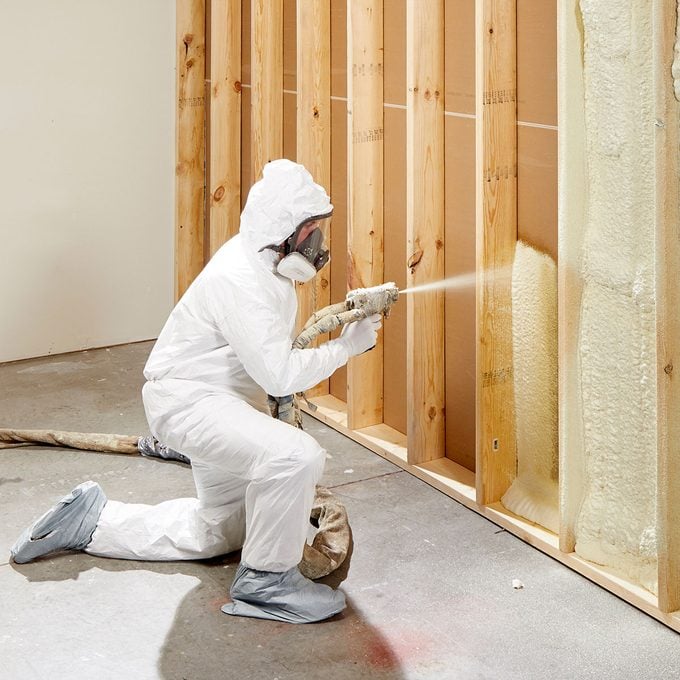Spray Foam Insulation
Updated: Dec. 13, 2022
There is no better performing insulation than closed cell spray foam. Find out why.
The benefits of closed cell spray foam
Closed-cell polyurethane spray foam has some pretty awesome qualities. It has a high R-value. It’s resistant to water, mold and insects. It expands into hard-to-reach nooks and crannies. Heck, it can even add structural support to walls and roofs. But it is expensive, so read on if you want to find out if this product is right for your next project.
What is closed cell spray foam?
Closed cell spray foam is made by mixing two chemicals. Each chemical travels down a separate hose and are mixed together as they are sprayed out of a gun at about 1100-1200 psi. The chemicals need to be heated to 130 degrees, so there is also a heating cable that runs next to the hoses. All three are wrapped up in a sleeve. The foam will expand anywhere from 30 to 60 times its liquid volume after it has been applied.
Foam density
Closed cell spray foam density is measured by weight. For example, a 12-in. square box filled with 2-lb. density foam (fully expanded) would weigh two pounds. And a 12-in. square box filled with 3-lb. density foam would weigh 3 pounds. Spray foam is generally used in the following densities:
2-lb. Density – Residential and commercial
3-lb. Density- Mostly used for commercial rooftops
R-value
Closed cell spray foam outperforms fiberglass, rock wool, and any other readily-available product on the market. The denser the foam, the more R-value per inch. On average, one inch of 2-lb. closed cell foam that has fully cured will perform at a R-6.8. That means a 2×6 wall cavity filled with five inches of foam will achieve an impressive R-34, almost double the R-value you could achieve with fiberglass.
Vapor barrier
Unlike other insulation systems, closed cell spray foam will create a vapor barrier if sprayed at a certain thickness. Years ago, approximately 2-1/2 inches of 2-lb. foam was required before qualifying as a vapor barrier. The chemicals being sprayed these days only require one inch of foam. Each chemical manufacture’s product performs a little differently, so the amount of foam required may vary slightly depending on the what brand is being sprayed.
Added Structure
Closed cell spray foam adds a tremendous amount of structure to a building assembly. There have been tests where three inches of spray foam was sprayed onto the underside of roof decking that was just resting on roof trusses without any fasteners holding the panels down. After the foam had cured, the decking could not be removed without destroying the trusses.
Closed cell spray foam is versatile
Spray foam can be used for many different applications:
- Walls
- In floor assemblies
- Attics
- Under slabs for radiant heat
- Footings and foundation walls exterior
- Interior walls
- Hot roofs
- Ice houses
- Insulated trailers
Pros and cons of spay foam insulation:
Compared to other forms of insulation, closed cell spray foam has more pros than cons:
Pros:
- Fast installation
- Best R-value per inch
- Customizable- you can spray it to any shape or size cavity
- Air barrier and vapor barrier in one
- Adds structure to the house
- Can be used above grade
- Can be used below grade
- Great for keeping rodents out
- Provides the maximum comfort in the home
Cons:
- Need to prep the area for over-spray (mask of windows, doors, etc.)
- If installed improperly, it can expand out and bow partition walls, backing, etc.
- Can expand and bow out sheathing that has not been properly fastened
- If installed too thick, it can have issues with off-gassing harmful fumes
- Needs to be covered (except rim joists) with a fire retardant or an approved building component like drywall
- Not as good at sound proofing than other insulation
- It costs more
How much does closed cell insulation cost?
The price has dropped in the last decade, but closed cell insulation is still an expensive option. A fiberglass installation cost approximately $.05 for every one R-value per square foot. Foam costs about $.15 per R-value per one square foot. So, if it costs $4,000 to insulate an entire house in fiberglass, it would cost a minimum of $12,000 to spray in closed cell foam. Although expect to pay even more because the beauty of this product is that you can get more R’s out of the same space.




















